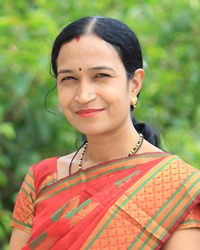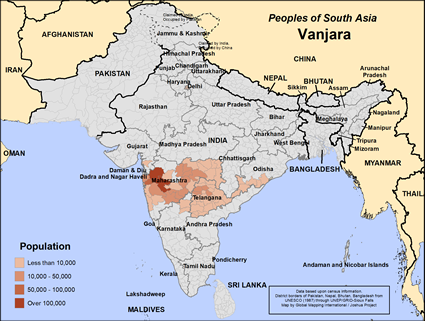Vanjara in India

Photo Source:
Sonam Prajapati - Pixabay
|

Map Source:
People Group Location: Omid. Other geography / data: GMI. Map Design: Joshua Project
|
| People Name: | Vanjara |
| Country: | India |
| 10/40 Window: | Yes |
| Population: | 967,000 |
| World Population: | 967,000 |
| Primary Language: | Marathi |
| Primary Religion: | Hinduism |
| Christian Adherents: | 0.00 % |
| Evangelicals: | 0.00 % |
| Scripture: | Complete Bible |
| Ministry Resources: | Yes |
| Jesus Film: | Yes |
| Audio Recordings: | Yes |
| People Cluster: | South Asia Hindu - other |
| Affinity Bloc: | South Asian Peoples |
| Progress Level: |
|
Introduction / History
The Vanjara or Banjara originally came from the western Indian state of Rajastan. Their main occupation before the British period was transporting salt, cattle and grain. Their name means "dwellers of the forest or jungle." During colonial times and the coming of the railroads, the Vanjara ceased their nomadic ways and settled down to become farmers. The Vanjara now grow rice, other grains, vegetables and fruit for themselves and to sell to others. They also raise cattle for dairy products and sale. The Vanjara also make bamboo products like baskets and mats to sell.
In the Vanjara community there is a wide disparity in their education levels. Some have college educations while most are barely literate or illiterate.
In most Indian states they are a Scheduled Class meaning they are eligible for guaranteed spots in universities and public service.
The primary language of the Vanjara is Marathi. Some others speak Telegu and other regional Indian languages.
Where Are they Located?
The vast majority of the Vanjara live in Maharashtra, west India. Some also live in Telangana and other regions of India.
What Are Their Lives Like?
The formerly nomadic Vanjara have settled down to live as farmers. One source said that the men are allowed to eat meat except for beef while the women must be vegetarians. The women work in the homes and in the fields. They are especially skilled in embroidery. The men also work in the field and make things to sell for currency. Unfortunately, most children receive only a minimal education and must work in agriculture to help support their families.
The Vanjara are endogamous, they prefer to marry within their group. Families arrange marriages. Sons inherit property upon the death of their fathers. They create their dead except for young children who are buried.
What Are Their Beliefs?
The Vanjara practice Hinduism, the ancient religion of India. They worship and serve the many gods of the Hindu pantheon. They offer food, incense and flowers at Hindu temples and at household shrines.
Sevala or Sevabhaya is the most important saint of the Banjara. He was a cattle merchant of the 18th century who lived an exemplary of morality. He was a musician and devoted to Durga, the mother-warrior goddess.
Banjara people celebrate the festival of Teej during Shravana (the month of August).
This holiday celebrates the monsoon season and the god Shiva and goddess Parvati.
The Vanjara also celebrate the yearly Hindu festivals, of Holi, the festival of colors, Diwali, the festival of lights and Navratri, the nine-day festival of autumn.
What Are Their Needs?
The Vanjara need to hear the life-changing message of Jesus Christ in a way they can understand. Christian teachers could help with the educational needs of their children. Agricultural experts could increase the crop yields of their lands. The Vanjara must see that Durga and Shiva will not help them obtain salvation and that their only hope is Christ.
Prayer Points
Pray that God moves Indian Christians to reach out to the Vanjara and share the gospel with them.
Pray Christian workers come to live among the Vanjara and show them the love and mercy of God.
Pray the Lord wins some Vanjara to Himself and that Bible-believing churches are planted in their community.